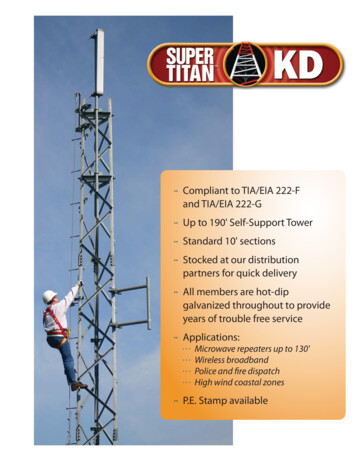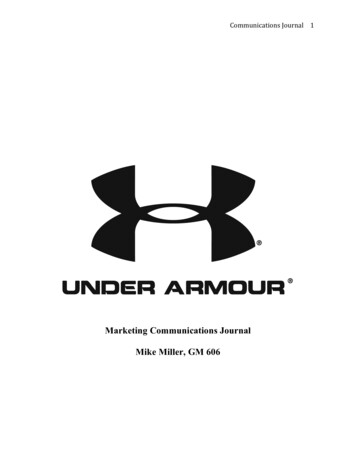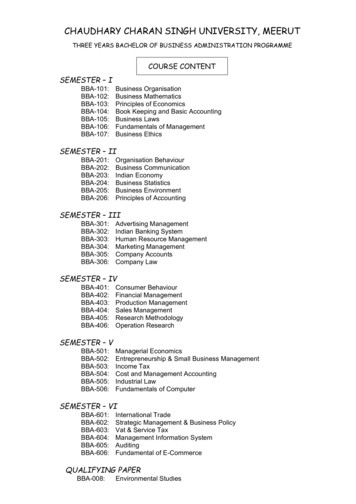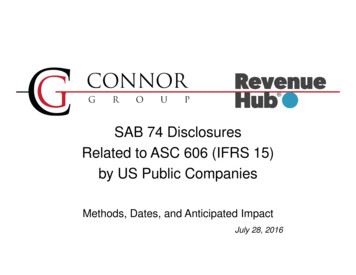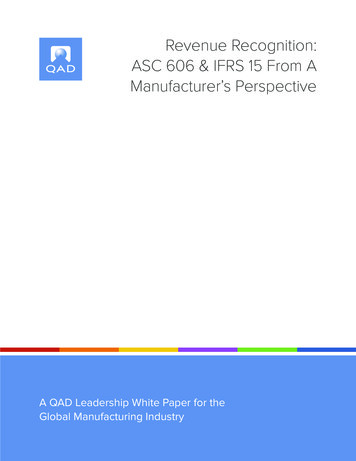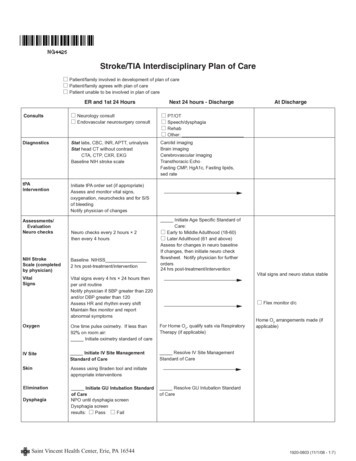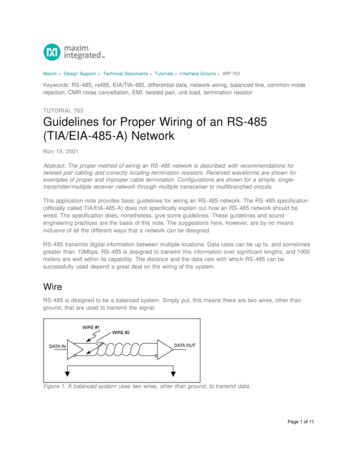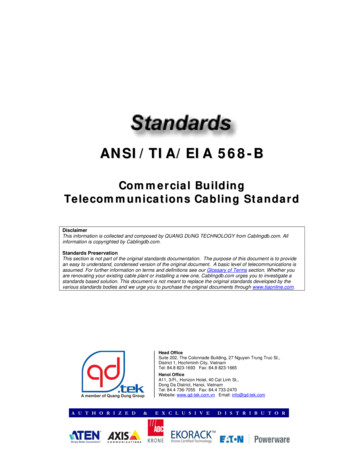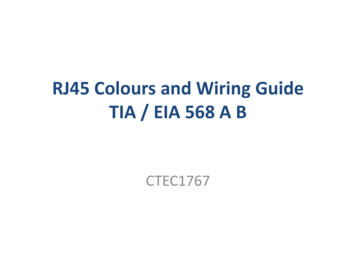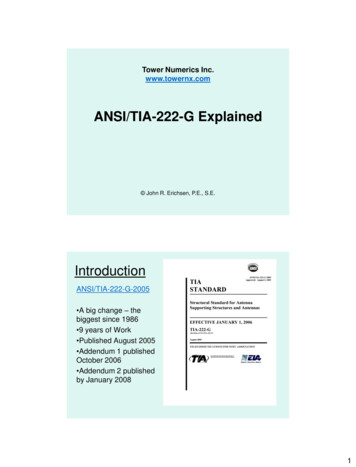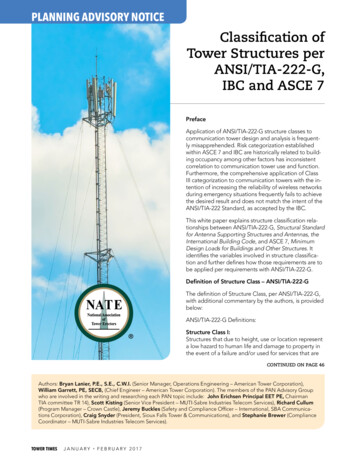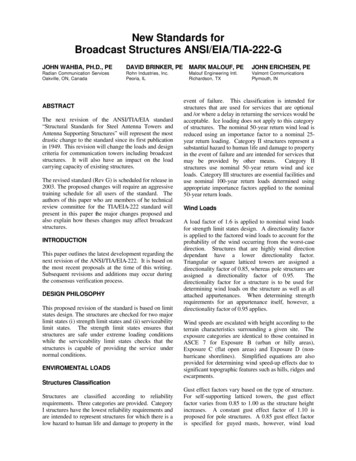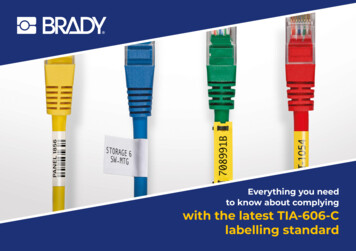
Transcription
Everything you needto know about complyingwith the latest TIA-606-Clabelling standard
CONTENTS03Why use the latest labelling standards?05A brief history of the TIA-606 standard06The latest standard: TIA-606-C07What’s new in TIA-606-C?09Why follow TIA 606-C?11How to properly identify cables according to TIA-606-C12How to make it easier to follow TIA 606-C:12 6 features your handheld printer should have14 Top 3 properties to look for in labels16 Top 5 functions to look for in label software172What now?
Why use thelatest labellingstandards?Effective cable labelling helps you addvalue to your operations with organisedinstallations that you can take pridein. Keeping up with best practicescan benefit your company and yourcustomers with increased efficiency,profitability and customer satisfaction.Properly labelled systems benefit allof us - installers and contractors, ITtechnicians, owners and businesses.The data explosion - Labelling hasbecome far more important in recentyears with the rise in data centergrowth and implementation of TIAlabelling standards, including the latestTIA-606-C standard.3
Here today, gone tomorrow Network structure is never static and isalways changing to keep up with newtechnology and increased bandwidthrequirements. Cables placed today willbe replaced tomorrow.The wireless world needs to bewired - As we move to a “wireless”world, the amount of cabling in facilitieswill increase as more devices areconnected and dated systems areupgraded.An investment worth making - Whilelabelling is only one part of a successfulstructured cabling or data centerinstallation, it plays an important role inensuring maximum uptime and auditcompliance for your customers.75%of data moving rightnow is generatedby machines andbuilding automation.4
A brief history of theTIA-606 labelling standardIn 2002, the Telecommunications Industry Association(TIA), which develops standards for the information andcommunications technology industry, set the first voluntaryTIA-606-A standard.This established a minimum level of information that shouldbe included on cable labels. It defined a labelling standardthat maps a cable precisely to the floor, telecom room,and patch panel position or block position on which it’sterminated. It included both colour-coded and alphanumericguidelines for all networking and structured cablingcomponents, which set it apart as a logical and sensiblesolution.The move to TIA-606-B. In 2012, the TIA updated thestandard to TIA-606-B, which included specificationsfor labelling and administrative best practices acrossall networked systems classes. It covered more facilityclasses of every size and type, from small office buildingsto large commercial enterprises, corporate campuses anddata centers, and added more granularity to identificationlocations within each of these facilities.In July 2017, the standard was updated to its current “C”revision.5
The latest standard:TIA-606-CThe TIA-606-C Standard specifies administration systems fortelecommunications infrastructure within buildings (includingcommercial, industrial, residential, and data center premises)and between buildings. This infrastructure may range in sizefrom a building requiring a single telecommunication space(TS) and associated elements, to many TSs and associatedelements in multiple campus locations. The standard appliesto administration of telecommunications infrastructure inexisting, renovated, and new buildings.Colour codingColour coding labels is recommended, but not required.Compliant coding may be accomplished using colour labelsor colour bands.6
What’s new in TIA-606-C?Much of the TIA-606-B standard still applies within theTIA-606-C standard, but there are some new additions andupdates.Annex D: Annex D provides additional guidelines for theadministration of cabling supporting remote powering,including a cable bundle identifier scheme. It’s an importantdevelopment because it allows automatic infrastructuremanagement systems from different manufacturers to worktogether.Changes to the identifier scheme fortelecommunications grounding and bonding systemelements: These changes specify the use of termscompatible with ISO/IEC 30129. Legacy terms used inversions of the TIA-607 standard earlier than revision C alsowill be allowed.7It’s an importantdevelopmentbecause itallows automaticinfrastructuremanagementsystemsfrom differentmanufacturersto work together.
Identifier schemes for telecommunicationsbonding and grounding system elementschanged to align with TIA-607-C: BCT (bonding conductor for telecommunications)changed to TBC (telecommunications bondingconductor) RGB (rack grounding busbar) changed to RBB (rackbonding busbar) GE (grounding equalizer) changed to BBC (backbonebonding conductor) TGB (telecommunications grounding busbar) changed toSBB (secondary bonding busbar) TMGB (telecommunications main grounding busbar)changed to PBB (primary bonding busbar)Additional updates: TIA-606-B-1 content replaced with a reference to TIA5048 (adaption of ISO/IEC 18598) The preference for an ISO/IEC TR 14763-2-1 compatibleformat for new administration systems was removed Table summarising variables used in identifier formatsadded8
Why follow TIA-606-C?Makes your job easier - Following the standard takes theguesswork out of creating labels in the office or on the fly.Improves your efficiency - Reduce time spent creatinglabels to streamline your entire installation and labellingprocess.Best practice - TIA-606-C is the industry standard, makingthe network easier to follow for your customer’s current andfuture team members.The mark of professionalism - Clear, durable labellingaccording to TIA-606-C standards is a sure sign of yourexperience and expertise.Ensures compliance with warranties - Some cablewarranties are dependent upon successful labellingand documentation being turned in directly to the cablemanufacturer as proof of system installation. Since cablewarranties are a key factor in many buyers’ purchasingdecisions, successfully certifying a system by supplyingthis type of information to the manufacturer is extremelyimportant.Improves record keeping - The standard requires youto link a record for each identifier that is printed on alabel, allowing your customer to have a well-documentedinfrastructure that can be understood and managed byanyone responsible for making moves, adds or changes.9Following the standardtakes the guessworkout of creating labels inthe office or on the fly.
Increases customer satisfaction - Customers appreciatethat their projects, whether large or small, are installed in fullcompliance with all applicable standards. From the buildingowner’s perspective, a non-labeled plant becomes a liabilitybecause they can’t get competent maintenance work donecost-effectively. It also reduces the time and cost associatedwith identifying and tracing a cable when problems occur orwhen a move, add or change is required.Creates new business opportunities - Installerssometimes turn down repair and maintenance bids becausecable tracing is labour-intensive and time-consuming.Adopting TIA-606-C standards makes it easier for you tobid competitively on future jobs when expansion occurs ormaintenance is needed.Reduces liability - Future maintenance workers canperform repairs, installation updates and upgrades in a safer,more secure way, with a reduced risk of human error.Faster troubleshooting - Being able to identify informationabout cables quickly makes it faster and easier totroubleshoot issues.Brady can support you with any of your identificationchallenges. Just contact us10
How to properlyidentify cablesaccording toTIA-606-CEach of the following components mustbe clearly labelled with the appropriateidentifiers: Telecommunications space Data center room grid Racks and cabinets Patch panels Ports Cabling Pathways Work area outlets Grounding busbars Firestop locations11Telecom Room AFloor 1Original LINKIdentifierPatch Panel BPort 11A - B01Patch Panel at Rack Unit 35LINK Identifier notterminated in thesame spaceRack 1Telecom Room 1APort 8Horizontal Link Identifier1A.1-35.08.LNKPort 06LINK Identifierterminated in thesame spaceCabinet KB13Patch Panel at Rack Unit 41Patch Panel at Rack Unit 42Cabinet BB13Port 06BB13-42:06/KB13-41:06Ports 01-06Patch Panel atRack Unit 42Patch PanelIdentificationCabinetBB13Cabinet KB13toPatch Panel at Rack Unit 41Ports 01-06BB13-42 p 01-06 to KB13-41 p 01-06
How to make it easier to follow TIA-606-CChoosing the right handheld printer, labels and software can make it easy to create labels that follow TIA-606-C guidelines.6 features your portable printer should have:1. Wireless Bluetooth connectivity - These capabilities allow you to set up and print labels from any location. You cancreate your own network, connect a laptop or tablet to your printer, and access data from file sets to print accurate labelsin the field.2. 300 DPI high-resolution printing - When you’re printing 11-12 characters per line on a 2” label (51mm), you needhigh-resolution printing to make it legible. Look for a high DPI that will print labels with clear text, UPC codes, industrysymbols and graphics.3. USB port - Import structured text data sets (such as .CSV files), lists and graphics from your laptop or tablet, which alsoreduces keying mistakes. You can also use it to plug in a full-size keyboard for bigger jobs.4. Built-in sequencers - Look for built-in macros so you can download and print custom or preformatted label templates,as well as run and print alphanumeric sequences.5. Barcoding capabilities - Make sure this functionality is built into your printer’s firmware so you can print bar codes andenable RFID tracking of assets and materials.6. Cooperation with benchtop printers - Make sure your portables collaborate with your benchtop units so you caneasily share data and files, and print on the go.12
Other features to look for: A large and well-lit screen for quick viewing andselection of labels Formatted label designs Easy-to-navigate menus Storage allowance and PC connectivity for downloadingdata Smart application keys with preformatted templates,for the types of labels needed for electrical, telecom,datacom, audio/video and security system work. The capability to make both continuous labels anddie-cut labels and automatic label setup, allowing theprinter to automatically recognise the label part installedand default to the correct rotation, format, size and fontwhen it is turned on Rechargeable NiMH batteries that allow printing morethan 2,000 labels on a single charge Rugged construction Automatic smart font-sizing technology The ability to accept a variety of interchangeable tapecartridges to create different types of labelsWant all this and more? Check out the BradyBMP61 printer, our best handheld printer forefficient identification of wires, cables andcomponents.See how the printer works!13EFFECTIVE FLOOR MARKING: 9 TIPS
Top 3 properties to look for in labels:1. Durability - Labels should be waterproof, tear resistantand scratch resistant, and stay attached over time. Inkshould be just as rugged – to remain legible over time,even in challenging conditions.2. The right stock - It’s important to select a materialthat’s made for your specific application andenvironment.3. Easy to read - Choose the right sizes and colours solabels are easy to read on the wires you’re installing.Discover professional and reliable labels forcable & component identification14
TIA/EIA-606 cable colour codesUsing colour-coded labels gives visual clues as to what the cables are used for and how they’re connected to the panel orgrid. Coloured labels are versatile, and they’re easier to install or change than a wire jacket.PantoneIndicationDescriptionOrange 150cDemarcation pointDemarcation point (central office termination)Green 353cNetwork connectionTermination of network connections on the customer side of the demarcation pointPurple 264cCommon equipmentTermination of cables originating from common equipment (pbx’s, computers, lan’s andmultiplexers) white/silver in Canada.WhiteFirst level backboneFirst level backbone telecommunications media termination in the building containing themain cross-connect (main cross-connect to tr or main cross-connect to local intermediatecross-connect). Purple in Canada.Grey 422cSecond levelbackboneSecond level backbone telecommunications media termination in the building containingthe main cross-connect (local intermediate cross-connect to tr). Purple (USA) or white(Canada) to identify second level backbone terminations in buildings not containing themain cross-connect.Blue 291cHorizontal cablingTermination of station telecommunications media required only at the tr and equipmentroom end of the cable not at the telecommunications outlet.Brown 465cInterbuildingbackboneInterbuilding backbone cable terminations (main cross-connect to remote intermediatecross-connect)Yellow 101cAuxiliary &miscellaneous circuitsTermination of key telephone systemsRed 184cKey telephonesystemsAreas that may expose employees to special physical or health hazards, risk of collidingwith obstacles, of falling or of objects falling.15
Top 5 functions to look for in label software:1. Import/export - Automatically extract and importdata from other programs such as CAD packages,spreadsheets and databases, saving you time andmoney.2. Label selection - This function allows you toautomatically select the optimum label for a particularapplication, simplifying and speeding up your labelcreation.3. Text and legends - Generate text, numbers andlegends that are compliant with industry standards,including UL, ANSI, TIA/EIA.4. Built-in app-specific sequencers - This built-intool can handle multiple alphanumeric sequences andsequence multiple areas within the facility, simplifyingyour labelling duties.5. Mirror print - Print to both sides of the label to improvereadability no matter how the wire is positioned in thenetwork
How to make it easier to follow TIA-606-C Choosing the right handheld printer, labels and software can make it easy to create labels that follow TIA-606-C guidelines. 6 features your portable printer should have: 1. Wireless Bluetooth connectivity - These capabilities allow you to set up and print labels from any location. You canFile Size: 1MBPage Count: 18
